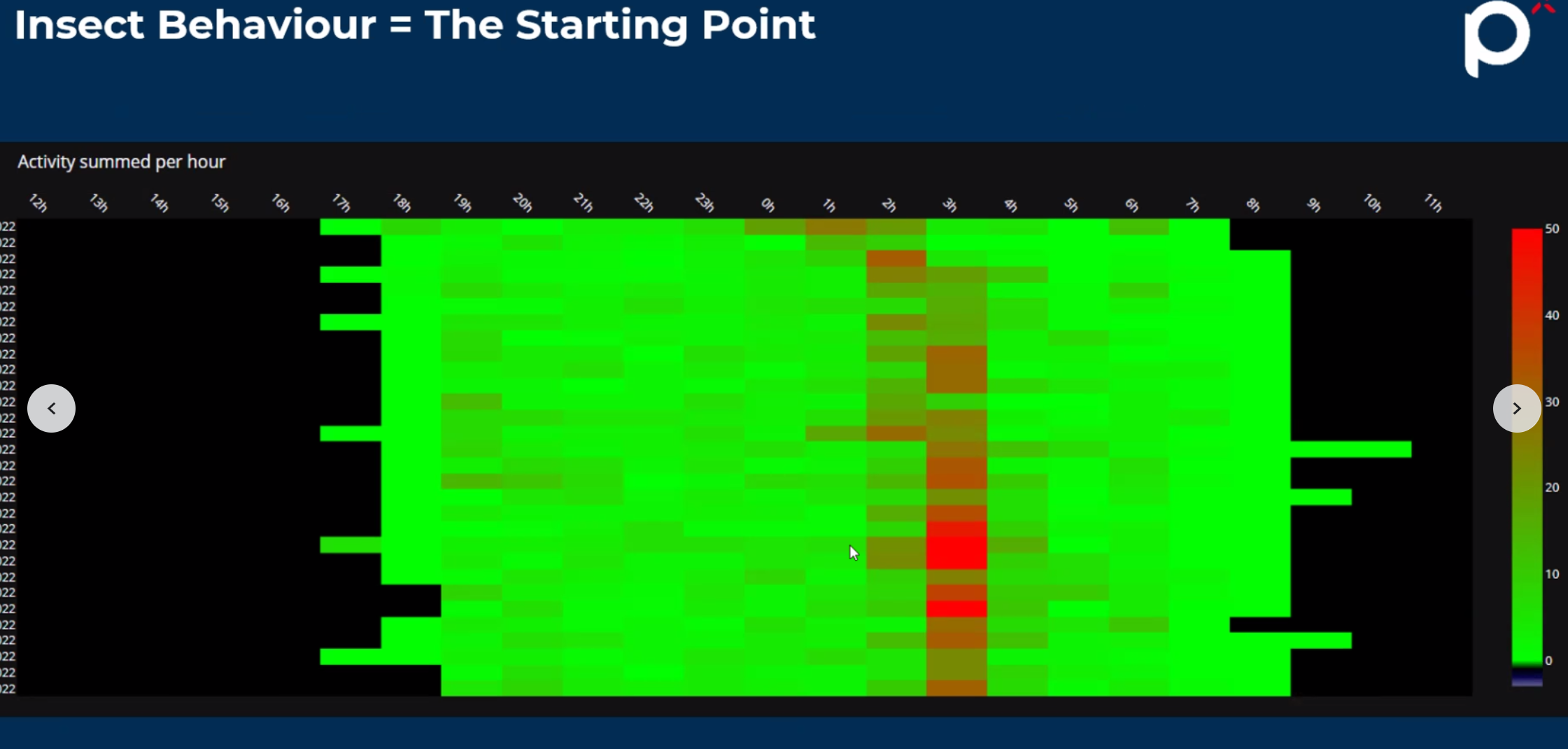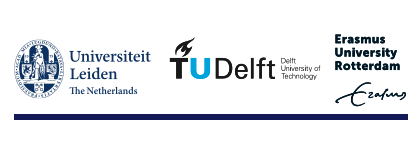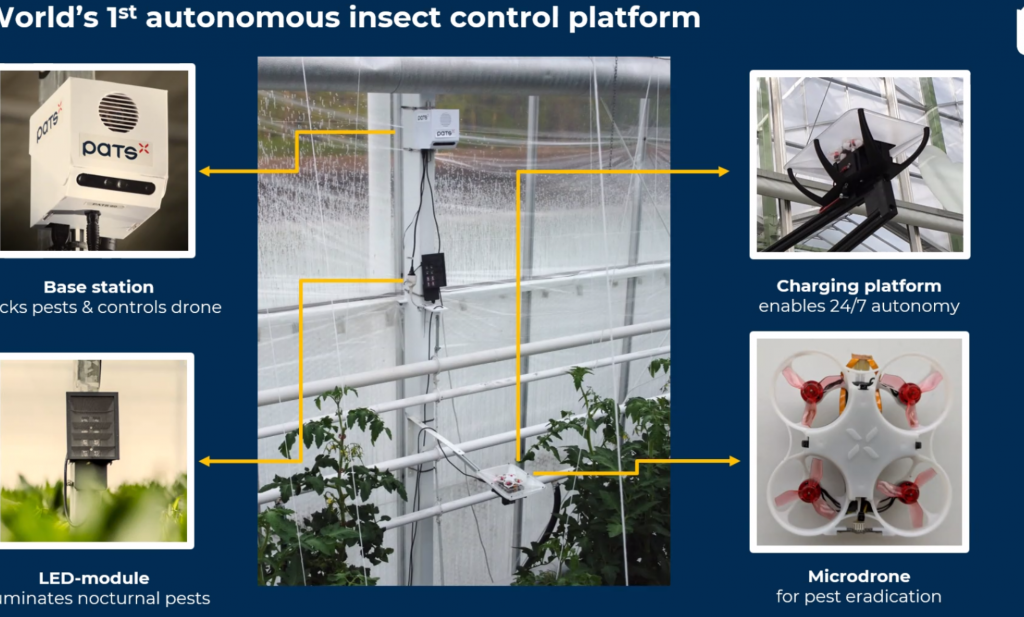To protect crops from pests and diseases, two approaches are generally used: crop protection products (which can be chemical or green), or biological control through antagonists (predatory mites, bacteria). During the Foodlog Digital Food Webinar on Feb. 28, 2023, PATS Drones showed that there is a third way. Pests can be prevented from attacking crops thanks to big data and mini-drones. Even before the grower realizes an infestation is coming.
Pest control is a tricky business because you cannot solve the problem until it has already become a problem. Moreover, consumers are asking for less pesticides and the EU has agreed in the Green Deal to reduce pesticide use by half by 2030. Spraying is no longer an effective solution. Even control with predatory mites or parasitic wasps is only really effective if the pest has already developed. In itself, a moth or butterfly is not harmful, but the caterpillar that hatches from its eggs is. How nice would it be if a grower could preventively monitor and intervene before his crops are affected?
Bram Tijmons, CEO and founder of the 5-year-old startup PATS Drones, discovered in practice that his technology can do just that. It started with a base station that continuously observes and records the movement of insects in a greenhouse. Just by observing, you gradually discover what's going on in the greenhouse. Even if no bugs flying around could be seen, inspection in the plants found no bugs and the traps were also clean, the cameras revealed that insects were flying around. This only became evident when Tijmons processed the observation videos into data files. "We were onto something but we didn't know it had value," he says. When he realized that the first observations of moths flying around occurred weeks before growers saw signs of infestation, he figured the data was a goldmine for prevention.
 Monitoring data, PATS
Monitoring data, PATS
For example, it is common for growers of food crops to spray preventively in the early evening so that a greenhouse is safe to enter again in the morning. But the observation videos showed that insects are especially active between 03:00 and 04:00. Where a gerbera grower might not worry about 5 moths in 10 hours of observation, PATS records that minimal activity. "It's the growers who have to do the interpretation, but PATS can predict," Tijmons said. “We can also suggest a meaningful customized treatment, without chemicals or other agents."
Mini-drones
Parallel to a period of intensive further development of the observation data and data processing, PATS also focused on creating mini-drones, which can instantly eliminate the flying insects. The PATS software calculates the optimal interception trajectory and the flying insect dies in the propellers of the drone. The result is a fully automatic system for pest monitoring and control. No humans are involved. The PATS drones attack the flying insects from the base station and return there to recharge. Small as they are, they are robust enough to last from six months to a full year. After that, the components are reused to make new ones.
 The world's first autonomous insect control platform
The world's first autonomous insect control platform
The big question for PATS - and for the webinar participants - is how to move forward. Although PATS has gained a foothold within horticulture thanks to a holistic approach, in which Tijmons went on a discovery tour with growers, there are many more possibilities. "This technology also works in low-tech greenhouses, in ports, in storage sheds, and in Africa." It could be an affordable, safe and reliable new method of insect control. Even outdoors, although there are additional obstacles to overcome there, such as aviation regulations - for self-flying drones, legislation hasn't advanced in any way in 5 years.
100% vegan chocolate
An animated conversation unfolds among the webinar participants about how to turn this innovative technology into a commercially viable proposition. Take the example of chocolate. The most common cocoa bean processing requires the use of pesticides to get rid of the large numbers of moths in warehouses. Therefore, chocolate contains both pesticide residues and processed moths - animal proteins. With the PATS drones, completely moth-free, i.e. vegan, chocolate is no longer a pipe dream. "Moth-free chocolate is definitely a business proposition for vegan youth," Dick Veerman suggests.
Moderator Tiffany Tsui sees the potential of the Digital Food network: "let this be the first concrete use case where we take things one level further," she challenges Gui Llerno, of Bühler (speaker during the previous webinar in the Digital Food series). Llerno is enthusiastic and will relay the contact within Bühler. Moth-free chocolate is suddenly conceivable, whereas until today you thought chocolate could not be animal-free.
We were onto something but we didn't know it had valueValue
Bram Tijmons, CEO and founder of the 5-year-old startup PATS Drones, discovered in practice that his technology can do just that. It started with a base station that continuously observes and records the movement of insects in a greenhouse. Just by observing, you gradually discover what's going on in the greenhouse. Even if no bugs flying around could be seen, inspection in the plants found no bugs and the traps were also clean, the cameras revealed that insects were flying around. This only became evident when Tijmons processed the observation videos into data files. "We were onto something but we didn't know it had value," he says. When he realized that the first observations of moths flying around occurred weeks before growers saw signs of infestation, he figured the data was a goldmine for prevention.
 Monitoring data, PATS
Monitoring data, PATSFor example, it is common for growers of food crops to spray preventively in the early evening so that a greenhouse is safe to enter again in the morning. But the observation videos showed that insects are especially active between 03:00 and 04:00. Where a gerbera grower might not worry about 5 moths in 10 hours of observation, PATS records that minimal activity. "It's the growers who have to do the interpretation, but PATS can predict," Tijmons said. “We can also suggest a meaningful customized treatment, without chemicals or other agents."
Mini-drones
Parallel to a period of intensive further development of the observation data and data processing, PATS also focused on creating mini-drones, which can instantly eliminate the flying insects. The PATS software calculates the optimal interception trajectory and the flying insect dies in the propellers of the drone. The result is a fully automatic system for pest monitoring and control. No humans are involved. The PATS drones attack the flying insects from the base station and return there to recharge. Small as they are, they are robust enough to last from six months to a full year. After that, the components are reused to make new ones.
 The world's first autonomous insect control platform
The world's first autonomous insect control platformThe big question for PATS - and for the webinar participants - is how to move forward. Although PATS has gained a foothold within horticulture thanks to a holistic approach, in which Tijmons went on a discovery tour with growers, there are many more possibilities. "This technology also works in low-tech greenhouses, in ports, in storage sheds, and in Africa." It could be an affordable, safe and reliable new method of insect control. Even outdoors, although there are additional obstacles to overcome there, such as aviation regulations - for self-flying drones, legislation hasn't advanced in any way in 5 years.
Moth-free chocolate is definitely a business proposition for vegan youthDrones can also be an interesting solution for warehouses and for export products. Think about using predatory mites to control pests: if you export your products, you don't want to transfer any exotics. With drones, you don't have that - possible - problem. However, having a new control method approved takes many years and costs hundreds of thousands of dollars. "We need partners," says Tijmons. "Every country, every sector, every product has to find out for itself what the possibilities are, because the new technology is intervening in existing business models." The principle of monitoring and drones is simple, but who is going to pay for it and who is reaping the benefits? In horticulture, growers have to protect their crops, but in other sectors, objections may arise such as "if we automate this, it will be much cheaper [because fewer crop protection products and less time are needed, editor's note] and how do we charge for that?". Further, says Tijmons, "we need growers and marketers, and also pressure from consumers to initiate the change."
100% vegan chocolate
An animated conversation unfolds among the webinar participants about how to turn this innovative technology into a commercially viable proposition. Take the example of chocolate. The most common cocoa bean processing requires the use of pesticides to get rid of the large numbers of moths in warehouses. Therefore, chocolate contains both pesticide residues and processed moths - animal proteins. With the PATS drones, completely moth-free, i.e. vegan, chocolate is no longer a pipe dream. "Moth-free chocolate is definitely a business proposition for vegan youth," Dick Veerman suggests.
Moderator Tiffany Tsui sees the potential of the Digital Food network: "let this be the first concrete use case where we take things one level further," she challenges Gui Llerno, of Bühler (speaker during the previous webinar in the Digital Food series). Llerno is enthusiastic and will relay the contact within Bühler. Moth-free chocolate is suddenly conceivable, whereas until today you thought chocolate could not be animal-free.
Related




Maar wat gaat er gebeuren als AI die minihelicoptertjes opdracht geeft alleen nog maar paperclips te maken?